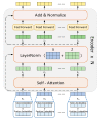AMMVF-DTI: A Novel Model Predicting Drug-Target Interactions Based on Attention Mechanism and Multi-View Fusion
- PMID: 37762445
- PMCID: PMC10531525
- DOI: 10.3390/ijms241814142
AMMVF-DTI: A Novel Model Predicting Drug-Target Interactions Based on Attention Mechanism and Multi-View Fusion
Abstract
Accurate identification of potential drug-target interactions (DTIs) is a crucial task in drug development and repositioning. Despite the remarkable progress achieved in recent years, improving the performance of DTI prediction still presents significant challenges. In this study, we propose a novel end-to-end deep learning model called AMMVF-DTI (attention mechanism and multi-view fusion), which leverages a multi-head self-attention mechanism to explore varying degrees of interaction between drugs and target proteins. More importantly, AMMVF-DTI extracts interactive features between drugs and proteins from both node-level and graph-level embeddings, enabling a more effective modeling of DTIs. This advantage is generally lacking in existing DTI prediction models. Consequently, when compared to many of the start-of-the-art methods, AMMVF-DTI demonstrated excellent performance on the human, C. elegans, and DrugBank baseline datasets, which can be attributed to its ability to incorporate interactive information and mine features from both local and global structures. The results from additional ablation experiments also confirmed the importance of each module in our AMMVF-DTI model. Finally, a case study is presented utilizing our model for COVID-19-related DTI prediction. We believe the AMMVF-DTI model can not only achieve reasonable accuracy in DTI prediction, but also provide insights into the understanding of potential interactions between drugs and targets.
Keywords: drug repositioning; drug–target interaction; graph attention networks; multi-head self-attention mechanism; neural tensor networks.
Conflict of interest statement
The authors declare no conflict of interest.
Figures







Similar articles
-
MCL-DTI: using drug multimodal information and bi-directional cross-attention learning method for predicting drug-target interaction.BMC Bioinformatics. 2023 Aug 26;24(1):323. doi: 10.1186/s12859-023-05447-1. BMC Bioinformatics. 2023. PMID: 37633938 Free PMC article.
-
Drug-Target Interaction Prediction Using Multi-Head Self-Attention and Graph Attention Network.IEEE/ACM Trans Comput Biol Bioinform. 2022 Jul-Aug;19(4):2208-2218. doi: 10.1109/TCBB.2021.3077905. Epub 2022 Aug 8. IEEE/ACM Trans Comput Biol Bioinform. 2022. PMID: 33956632
-
Drug-target interaction predictions with multi-view similarity network fusion strategy and deep interactive attention mechanism.Bioinformatics. 2024 Jun 3;40(6):btae346. doi: 10.1093/bioinformatics/btae346. Bioinformatics. 2024. PMID: 38837345 Free PMC article.
-
Comparative analysis of network-based approaches and machine learning algorithms for predicting drug-target interactions.Methods. 2022 Feb;198:19-31. doi: 10.1016/j.ymeth.2021.10.007. Epub 2021 Nov 1. Methods. 2022. PMID: 34737033 Review.
-
Graph neural network approaches for drug-target interactions.Curr Opin Struct Biol. 2022 Apr;73:102327. doi: 10.1016/j.sbi.2021.102327. Epub 2022 Jan 21. Curr Opin Struct Biol. 2022. PMID: 35074533 Review.
Cited by
-
MIFAM-DTI: a drug-target interactions predicting model based on multi-source information fusion and attention mechanism.Front Genet. 2024 May 6;15:1381997. doi: 10.3389/fgene.2024.1381997. eCollection 2024. Front Genet. 2024. PMID: 38770418 Free PMC article.
-
An Interpretable Deep Learning and Molecular Docking Framework for Repurposing Existing Drugs as Inhibitors of SARS-CoV-2 Main Protease.Molecules. 2025 Aug 18;30(16):3409. doi: 10.3390/molecules30163409. Molecules. 2025. PMID: 40871562 Free PMC article.
-
Machine Learning Empowering Drug Discovery: Applications, Opportunities and Challenges.Molecules. 2024 Feb 18;29(4):903. doi: 10.3390/molecules29040903. Molecules. 2024. PMID: 38398653 Free PMC article. Review.
-
Techniques and Strategies in Drug Design and Discovery.Int J Mol Sci. 2024 Jan 23;25(3):1364. doi: 10.3390/ijms25031364. Int J Mol Sci. 2024. PMID: 38338643 Free PMC article.
-
MVSF-AB: accurate antibody-antigen binding affinity prediction via multi-view sequence feature learning.Bioinformatics. 2025 May 6;41(5):btae579. doi: 10.1093/bioinformatics/btae579. Bioinformatics. 2025. PMID: 39363630 Free PMC article.
References
-
- Ezzat A., Wu M., Li X., Kwoh C. Computational prediction of drug-target interactions using chemogenomic approaches: An empirical survey. Brief Bioinform. 2019;20:1337–1357. - PubMed
MeSH terms
Grants and funding
LinkOut - more resources
Full Text Sources
Medical

